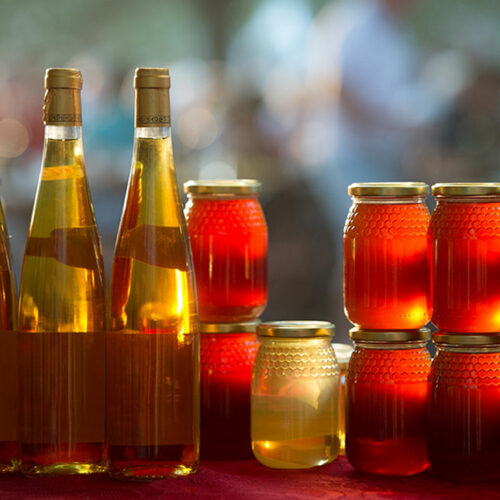Ah, mead! The golden nectar that has been enjoyed by royalty, warriors, and common folk alike for centuries. As someone who has spent countless hours experimenting with this divine drink, I can vouch for its alluring taste and charm. And if you’re reading this, chances are you’re looking to craft your very own batch of honey wine, and I must say, you’re in for a delightful journey. I’m here to guide you through this age-old tradition, which, in essence, is the marriage of honey, water, and time, occasionally enhanced with fruits and spices.
How To Make Mead Recipe Overview :
This recipe will yield about 5 liters of mead and requires a fermentation period of approximately 4-6 weeks, although the longer you allow it to age, the more refined its flavor will become. After fermentation, there’s an optional aging period which can range from a few months to several years, depending on your preference. The choice of honey is crucial; the more flavorsome, the better, as this will be the backbone of your mead’s taste profile.
Tools and Equipment
- Fermentation Vessel: A glass carboy or food-grade bucket with a lid will suffice. It’s essential to ensure it’s large enough to hold your brew and give it some breathing space.
- Airlock: This allows CO2 to escape without letting contaminants in.
- Long Spoon or Stirrer: To mix your ingredients thoroughly.
- Measuring Tools: Accurate measurements are essential, especially for additives.
- Bottles and Corks/Caps: For storing the finished mead.
Ingredients
- 1kg of a richly flavored honey of your choice
- 6g of acid regulator, preferably citric acid
- 30g of no-rinse sanitiser powder, like SureSan
- Extra honey for back-sweetening, as per taste
- 12g of yeast nutrients
- 2 Campden tablets
- 1 sachet of brewer’s or wine yeast
Instructions
- Sanitization: Begin by sanitizing all your equipment using the SureSan powder. It’s vital to prevent any unwanted microbes from interfering with the fermentation.
- Honey & Water: In your fermentation vessel, mix the honey with enough water to make up 5 liters. Stir until the honey is entirely dissolved.
- Acid & Nutrients: Add the citric acid and yeast nutrients, ensuring they’re thoroughly mixed in.
- Yeast Time: Sprinkle in the yeast, giving it a gentle stir to ensure even distribution.
- Airlock: Seal your fermentation vessel with the airlock.
- Fermentation: Allow the mixture to ferment in a cool, dark place for 4-6 weeks.
- Back-Sweetening: Once fermentation is complete if desired, add extra honey to taste.
- Preserve: Add crushed Campden tablets to stop fermentation and preserve the mead.
- Bottle: Transfer the mead into sanitized bottles, leaving sediment behind. Seal and store.
Nutritional Value (per serving)
Calories: 150
Carbohydrates: 28g
Protein: 0.1g
Fat: 0g
Sugars: 28g
Also Try: How to Make Fried Bread Recipe
FAQs
How do I know if my mead is fermenting correctly?
Answer: Fermentation can be identified by the presence of bubbles in the airlock, a foamy layer on the surface of the liquid, or a consistent release of carbon dioxide. If you notice these signs, your mead is fermenting. Additionally, a drop in the specific gravity (measured using a hydrometer) will also indicate fermentation progress. If you see no signs of fermentation after 72 hours of adding yeast, there could be an issue with the yeast’s viability or the environment (temperature or pH) may not be optimal.
Is it normal for my mead to have a strong yeast or sulfur smell during fermentation?
Answer: A strong yeast smell during the initial stages of fermentation is normal. However, a persistent sulfur or “rotten egg” smell can be a sign that your yeast is stressed. This can happen due to various reasons: insufficient nutrients, extreme temperatures, or an overly acidic environment. If this occurs, consider adding more yeast nutrients, ensuring the fermenting mead is at a temperature between 60°F and 70°F, and testing the pH to make adjustments if necessary.
How can I clear a cloudy mead?
Answer: Cloudiness in mead can be due to various reasons like suspended yeast, proteins, or pectins. To clear your mead:
Aging: Simply allowing the mead to age can often result in the particulates settling to the bottom.
Cold Crashing: This involves reducing the temperature of your mead to around 32°F (0°C) for a few days, promoting the settling of particulates.
Fining Agents: These are additives that bind to particles causing cloudiness, and making them heavy enough to settle. Common fining agents include bentonite and gelatin.
Can I flavor my mead with ingredients other than fruits and spices?
Answer: Absolutely! The world of mead-making is vast and open to experimentation. Beyond fruits and spices, many mead makers have successfully incorporated ingredients like coffee, chocolate, vanilla beans, and even certain types of wood chips for a barrel-aged flavor. Just remember that whatever you add will contribute flavors and potential sugars, which can affect fermentation and the final taste profile.
What’s the ideal storage condition for aging mead?
Answer: Mead, much like wine, benefits from being stored in a cool, dark, and stable environment. Ideal conditions would be a temperature between 55°F and 65°F (13°C and 18°C) with humidity levels around 50-70%. Consistency is key—frequent temperature fluctuations can negatively impact the aging process. Also, store the bottles on their side to keep the cork moist, preventing it from drying out and letting air into the bottle.
Remember, while guidance is essential, mead-making is as much an art as it is a science. Trust your instincts, take notes, and enjoy the creative process!
Conclusion
Mead making, with its blend of art and science, is a journey. Like any good adventure, it comes with its set of challenges, but the reward—a bottle of your handcrafted honey wine—is worth every drop of effort. Enjoy the process, relish the result, and here’s to many batches of liquid gold! Cheers!

Mead Recipe
Ingredients
- 1 kg of a richly flavored honey of your choice
- 6 g of acid regulator preferably citric acid
- 30 g of no-rinse sanitiser powder like SureSan
- Extra honey for back-sweetening as per taste
- 12 g of yeast nutrients
- 2 Campden tablets
- 1 sachet of brewer’s or wine yeast
Instructions
- Sanitization: Begin by sanitizing all your equipment using the SureSan powder. It's vital to prevent any unwanted microbes from interfering with the fermentation.
- Honey & Water: In your fermentation vessel, mix the honey with enough water to make up 5 liters. Stir until the honey is entirely dissolved.
- Acid & Nutrients: Add the citric acid and yeast nutrients, ensuring they're thoroughly mixed in.
- Yeast Time: Sprinkle in the yeast, giving it a gentle stir to ensure even distribution.
- Airlock: Seal your fermentation vessel with the airlock.
- Fermentation: Allow the mixture to ferment in a cool, dark place for 4-6 weeks.
- Back-Sweetening: Once fermentation is complete if desired, add extra honey to taste.
- Preserve: Add crushed Campden tablets to stop fermentation and preserve the mead.
- Bottle: Transfer the mead into sanitized bottles, leaving sediment behind. Seal and store.

